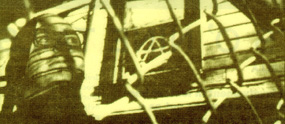AMERICAN LANGUAGE SHOW NOTES:
DANCING WITH THE DEAD
© Alan Reade, 1994 and 2020
911 Media Arts Center, Seattle, Washington, June 24 and 25, 1994
(8 p.m. and 10 p.m.--four shows altogether)
Artists' Television Access (ATA), San Francisco, California, October 7, 1994
Parts of this performance were premiered at the Idiot Wind showcase, Rm. 608, Seattle, Washington, March 24 and May 26, 1994.Performers and Participants
Alan Reade--Vocals, KeyboardSlugg Jello--Cello, Keyboard Programming
Jeri Francis--Electric Guitar
Anne Cooper--Choreography, Dancing Skeleton
Thomas Thew--Sound Production
Joe Dray--Video Production
Daniel--Video Production for Solo Version Adaptation
Geoff Manasse--Slide Images for "Stayin' Alive"
Sini Love Man--The Song "A Dash of Mystique" in "Dance of Disappearance"
Holly--Video Images of Performance
Notes
This piece was written as the final installment of the American Language series, the one dealing with death and renewal. I performed it out of order, number 3 instead of number 5, because of the untimely death of my friend Richard Hilton from AIDS-related causes in 1993. I felt that I wanted to honor Richard by plunging into a show about death not long after his passing; also, maybe I needed to do the performance then to express some grief. The first part of the show I wrote was a poem called "Death of the Document," which I read as a tribute to Richard at his memorial service in August of 1993.While putting together the performance, I began to question things like, What does it mean when somebody is gone? Why do we tend to remember only their saintly qualities, not their more human ones? And, more to the point, how does memory really work? The show included video and slide imagery, Slugg Jello on cello, Jeri Francis on electric guitar, and choreography by Anne Cooper, who appeared in the performance as a masked skeleton figure with whom I danced. Erotic photographic imagery by Geoff Manasse was featured as a backdrop for the finale, a Patti Smith–inspired version of the BeeGees' "Stayin' Alive."
The overall soundscape for this performance was based on the vowel sound "U," so the arc of the piece started off fast, descended (a "burial") in the middle, and then ascended to a high level of energy at the end (a "resurrection"). At the center of the piece was a sort of death ritual, where the audience sat in total darkness except for one candle burning and listened to digitally reproduced chanting, drumming, and then an operatic aria. During this part of the performance, I stayed on the floor, masked and covered--symbolically "laid to rest"--and then I rose to my feet. This was probably the most ritualistic of my performances; near the end, I handed out little bits of spice to eat (symbolizing Richard's funerary ashes) that were taken from Richard's herb shop that he had run in the years before he died. The tarot-card suit for this piece was Cups, which represents emotion, love, and remembrance.
The performance played for only two nights at 911 Media Arts Center, but we did two shows per night, so it played four times altogether. I then took it to ATA in San Francisco for one night, where several of my closest friends, who had also been good friends with Richard, attended. In addition to being a terrific ending for my performance series, we found it a fitting memorial for someone who had been artistic, productive, and inspiring. I feel that this show accomplished a lot for me on numerous levels, both artistic and personal, not the least of which was working out a lot of my fear of death. Before protease inhibitors, I (like so many people) had watched a lot of gay men around me live painfully and then die gruesome deaths. This performance gave me, and my audiences, a forum to process both some of the grief and some of the joy at remembering multitudes of people dear to us who--from our perspectives anyway--had died before their times.
Close this window to return to American Language.